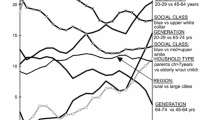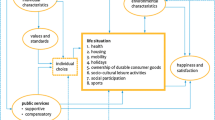Abstract
The properties of objective or subjective variables are commonly examined with reference to a set of mutually distinct but analogous social groups structured at a time point. The procedure fails to examine what is happening across the structured groups and therefore what is likely to be the role of the variables in differentiating or integrating the ordained set of social groups. A resolution of this issue is vital for the appraisal of a better quality of life because by definition it is always an ongoing phenomenon. The issue is examined with reference to its methodological implications and with respect to QOL data on India.
Similar content being viewed by others
Bibliography
Mukherjee, R.: 1983a, ‘On the study of quality of life in India’, in: Unesco (ed. and pub.), Quality of Life: Problems of Assessment and Measurement, Paris, pp. 49–109.
Mukherjee, R.: 1983b, The Second Study of Quality of Life in India, Paris, Unesco (SS. 83/Conf./CS/13/4).
Mukherjee, R.: 1983c, Classification in Social Research, Albany, State University of New York Press.
Author information
Authors and Affiliations
Rights and permissions
About this article
Cite this article
Mukherjee, R. Structure and processes of a phenomenon: The context of quality of life in India. Soc Indic Res 20, 555–579 (1988). https://doi.org/10.1007/BF03359558
Received:
Published:
Issue Date:
DOI: https://doi.org/10.1007/BF03359558




